|
|
|
Sort Order |
|
|
|
Items / Page
|
|
|
|
|
|
|
| Srl | Item |
| 1 |
ID:
188546


|
|
|
|
|
| Summary/Abstract |
This paper evaluates the effectiveness of a regulatory framework based on feed-in tariffs to promote small-scale PV on basis of empirical data for Germany between 2000 to 2021. We show that feed-in tariffs have so far failed to exploit the technical small-scale PV potential evenly across regions. This implies significant differences in the allocation of regulatory benefits and costs associated with the promotion of renewable energy sources, leading to a situation of increasing socioeconomic inequality: few counties benefit strongly and many counties bear the costs. Over the past 20 years, in addition to margin effects due to disproportionately high feed-in tariffs, this inequality has increasingly been driven by steadily rising self-consumption. This leads, on average, to differences of over 40 percent in effective electricity costs between households with and without PV. We conclude that the current regulatory framework is insufficient to bring solar PV up to the needed level and to distribute the associated benefits and costs equitably across households. Based on this, we derive guiding principles of a future regulatory framework that enables more effective scaling of small-scale PV.
|
|
|
|
|
|
|
|
|
|
|
|
|
|
|
|
| 2 |
ID:
188543


|
|
|
|
|
| Summary/Abstract |
Considering the close relationship between the automobile market and the oil market, as well as the increasing dependence on foreign oil in China, it is worth focusing on the impact of global oil price fluctuations on China's automobile markets. This paper investigates the impact of different fluctuations in the global oil market on China's automobile market returns. First, the ARMA-EGARCH-ARJI model is applied to describe the characteristics of global oil fluctuations. Then, we use three specific models to discuss the impact of the expected and unexpected global oil price shocks and the global oil price jumps and explore whether there are corresponding price jumps in the automobile markets. We find that there are asymmetric effects of the influences of the expected and unexpected global oil shocks. Moreover, there is a lag effect of the global oil price jumps on the automobile markets. In addition, global oil price jumps lead to ‘U-shaped’ responses in the automobile markets. In contrast to the literature, we introduce factors of price jumps into the subject market and the global oil market, and we discuss the effects of different types of global oil price shocks in detail, especially those concerning the influence of oil price jumps.
|
|
|
|
|
|
|
|
|
|
|
|
|
|
|
|
| 3 |
ID:
188564


|
|
|
|
|
| Summary/Abstract |
This article explores the dynamic coexistence of neoliberal and realist narratives in the EU's discourse on international green cooperation with a focus on Russia. Using critical discourse analysis and critical geopolitics, the article explores how the neoliberal and realist narratives were applied in the EU's international (Russia-focused) energy transition cooperation. The neoliberal narrative presupposed fine-tuned multilateralism and market openness, with an opportunity for Russia to join the EU's success story. The realist narrative was based on the notions of relative gains, strategic autonomy/sovereignty, market corrections by public authorities, borders and closed alliances, Russia was used in this narrative to encourage more EU autonomy and strategic partnerships. The article demonstrates how and why the geopolitical narrative was strengthened between 2020 and 2021. It reveals the similarities between the neoliberal and realist narratives regarding the policy framework and relative positions of the EU and Russia in the spacialisation of the green energy policy. As a result, no policy opening for selective engagement with Russia emerged; rather, the 2020–2021 discourse prepared the EU for a policy shift that it took to react to Russia's assault against Ukraine in February 2022.
|
|
|
|
|
|
|
|
|
|
|
|
|
|
|
|
| 4 |
ID:
188552


|
|
|
|
|
| Summary/Abstract |
Community Wealth Building (CWB) is a burgeoning international policy agenda for local economic development that seeks to enhance democratic ownership, retain the benefits of local economic activity and empower place-based economies and workers. Parallel to this, in the context of net zero transitions, there has been increasing interest in approaches to enhancing civil society and community ownership over local energy provision. However, in academic and practitioner debates, there has been very little interaction between these two strands of thinking and action on the need for radical change in current energy provision, particularly as part of a wider transformative change away from dominant neoliberal economic thinking, policies and structures.
|
|
|
|
|
|
|
|
|
|
|
|
|
|
|
|
| 5 |
ID:
188558
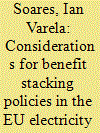

|
|
|
|
|
| Summary/Abstract |
Electricity Storage is a key activity in the European Union’s (EU) decarbonisation strategy. Indeed, storage facilitates the penetration of electricity from renewable sources into the grid by reducing the variability of renewable generation. Despite its importance, electricity storage is still perceived as a risky activity. The risk derives from the widespread need to secure multiple revenue streams in order to ensure profitability. This article investigates the risks influencing the development of electricity storage in the EU regulatory framework, focusing on benefit stacking. Benefit stacking refers to the diversification of services a storage asset can provide. This article evaluates some of the main regulatory barriers to benefit stacking in the EU electricity market and provides policy strategies to derisk this activity. The study is carried out using a multilevel analysis: the obstacles to stacking electricity storage services are investigated in EU law as well as in national law. After analysing the obstacles, policy recommendations are proposed to foster benefit stacking at both levels.
|
|
|
|
|
|
|
|
|
|
|
|
|
|
|
|
| 6 |
ID:
188559


|
|
|
|
|
| Summary/Abstract |
Load management is the practice of adjusting demand in an electricity system through remote control of—or incentives to operate—grid-edge technologies in alignment with system goals. Although load management functions as a distributed energy resource (DER) and can play a critical role in cost-effective deployment of renewable energy toward economy-wide deep decarbonization, there has been little energy transitions research on how electric grid actors initiate and manage DER deployments over time. We use interviews and archival research to compare case studies of electric cooperatives in the United States, tracing how cooperatives deployed more than 600,000 load management devices over 70 years. Using polycentricism as a frame, we find that DER deployments comprise common pool resources that are strategically created and negotiated across scales by different centers of decision-making over time. Our findings rebut the assumption that DER deployments are solely the result of policies or markets, showing that DER deployments are instead polycentric acts of cooperation and competition. DER deployments require diverse intermediaries within and across levels of deployment, from policy to users, over many years. We show that polycentric governance that builds vertical coordination across local and regional actors can support broad, deep, and distributed energy transition.
|
|
|
|
|
|
|
|
|
|
|
|
|
|
|
|
| 7 |
ID:
188550


|
|
|
|
|
| Summary/Abstract |
The COVID-19 crisis has imposed a rediscussion of energy transition, offering the chance of promoting socioeconomic and ecological resilience to the energy sector, crucial for the post-pandemic recovery. Our societies are faced with a unique opportunity for changing people's behaviours and improving their lives. In the EU, the Green Deal is saluted as a new package of policy interventions aiming at achieving social goals such as job creation and reducing economic inequality – mostly by means of renewable energy and resource efficiency. However, the ongoing energy transition has been affected by COVID-19-related policy measures. This work proposes to give insights into the EU citizens' pre-pandemic perception of some key renewable energy transition, sustainability and resilience factors, which may be crucial with a view to finding prime energy policy indications useful for the post-pandemic recovery. Making use of 2019 EU Eurobarometer data, selected aspects of EU citizens' perceptions of energy policy are evaluated. Logit regressions are estimated to render energy perceptions modelling. Results suggest evidence of interrelated renewable energy transition issues for the EU, including resilience, vulnerability, cooperation, competition, sovereignty, security, safety and climate change. The findings indicate important social and environmental implications for energy policy modelling. The diversity of sorting results, regional-level differences and embodied domestic characteristics allow for macro-regional explorations.
|
|
|
|
|
|
|
|
|
|
|
|
|
|
|
|
| 8 |
ID:
188555


|
|
|
|
|
| Summary/Abstract |
With expanding solar and wind power production, the topic of flexibility services attracts increased attention in the Swedish energy system. In this context, the potentials in using thermal storage capacities in district heating (DH) systems have been brought forward, primarily by academic scholars. Using a ‘grounded’ approach, this study investigates if professionals assigned to Swedish DH companies and electricity distribution system operators utilise, or plan to utilise, DH systems as flexibility services for the electricity grid. Original data was collected through semi-structured interviews, held with fourteen individuals affiliated to different actors in the Swedish energy system. These individuals were identified as being experts, or practically engaged, in using DH utilities as flexibility services for the electricity grid. The findings show that although technologies for coupling between DH systems and the electricity grid are already in place, initiatives for using DH systems as flexibility services for the electricity system are rare in Sweden. Coupling challenges stem from ownership and operation legislation frameworks, marginal incentives and a widespread focus on firm benefits rather than energy systems benefits. Identified initiatives for using DH systems for flexibility services are primarily run on a local scale, designed and propelled by small groups of engaged individuals.
|
|
|
|
|
|
|
|
|
|
|
|
|
|
|
|
| 9 |
ID:
188570


|
|
|
|
|
| Summary/Abstract |
Finance is crucial for the low-carbon energy transition. This research takes the solar PV technology as an example to explore whether having state-owned financial institutions, such as national development banks (NDBs), offers advantages in a country for mobilizing finance. By focusing on three selected country cases (The United States without NDBs, Germany with a big NDBs, and China with huge NDBs), the paper first reviews the evolution of solar PV finance mobilization in the three countries from the 1990s to 2018. It then examines the financial strategies and impacts of NDBs and the alternative approaches that the three countries use to address financial challenges for solar PV deployment at different stages. The paper finds that NDBs' direct financier role in the early deployment stage is most important and irreplaceable. Alternative policies can fulfill most facilitative roles of NDBs in unlocking private finance, except NDBs' learning bank role. NDBs' role in channeling information between governments and markets is also hardly replaceable. The paper provides insights for policymakers and implementers of countries aiming to set up NDBs to scale up low-carbon energy technologies.
|
|
|
|
|
|
|
|
|
|
|
|
|
|
|
|
| 10 |
ID:
188571
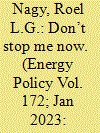

|
|
|
|
|
| Summary/Abstract |
Once a subsidy scheme is close to reaching its goal or loses political support, it may be terminated. An important question for policy makers is how to minimize the negative impact of the risk of subsidy termination on industrial investment. We assume the social planner aims to increase capacity and welfare and uses a subsidy, which has an uncertain lifetime, for the purpose. We examine a monopolist supplying an uncertain demand, faced with the option to expand capacity by irreversibly investing in small increments. We find that the firm installs capacity expansions sooner and, consequently, installs a larger capacity than a firm without a subsidy. A firm’s total investment during the subsidy’s lifetime increases with both the subsidy size and the likelihood of subsidy withdrawal. However, this happens at the cost of less investment directly after the subsidy has been retracted. The optimal subsidy size strongly depends on the point in time at which the social planner aims to maximize the welfare — the further into the future, the larger the welfare optimal subsidy. Furthermore, the welfare optimal subsidy size strongly depends on the social planner’s discretion over adjustments to the subsidy size.
|
|
|
|
|
|
|
|
|
|
|
|
|
|
|
|
| 11 |
ID:
188560


|
|
|
|
|
| Summary/Abstract |
This paper introduces the energy structure variables into the generalized cost function from the dual perspective of energy "structural dividend" and factor allocation distortion. It quantitatively estimates the factor allocative efficiency, cost elasticity and marginal cost of the energy decarbonization practice in China from 2004 to 2019. Estimation results show that: (i) there is a "structural dividend" effect of energy restructuring in China. On average, a 1% increase in the level of decarbonization of the energy structure reduces the total cost by 0.57% and the marginal cost by 5.846 billion yuan. Specifically, a 1% reduction in the share of coal consumption reduces the marginal cost by 4.590 billion yuan. (ii)Energy restructuring has accelerated factor allocation distortions in recent years. In terms of the impact of energy decarbonization on productivity growth, the inhibition of factor allocation distortion on productivity growth mainly comes from scale effect. (iii)Energy restructuring has a heterogeneous impact on productivity growth across provinces. Productivity growth in energy-consuming regions is lower than that in energy-supplying regions, while the regions where factor allocation distortions have a greater impact on productivity growth are mostly found in the central and western parts of the country where factor markets are less developed.
|
|
|
|
|
|
|
|
|
|
|
|
|
|
|
|
| 12 |
ID:
188548
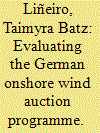

|
|
|
|
|
| Summary/Abstract |
Auctions are a highly demanded policy instrument for the promotion of renewable energy sources. Their flexible structure makes them adaptable to country-specific conditions and needs. However, their success depends greatly on how those needs are operationalised in the design elements. Disaggregating data from the German onshore wind auction programme into individual projects, we evaluated the contribution of auctions to the achievement of their primary (deployment at competitive prices) and secondary (diversity) objectives and have highlighted design elements that affect the policy's success or failure. We have shown that, in the German case, the auction scheme is unable to promote wind deployment at competitive prices, and that the design elements used to promote the secondary objectives not only fall short at achieving their intended goals, but create incentives for large actors to game the system.
|
|
|
|
|
|
|
|
|
|
|
|
|
|
|
|
| 13 |
ID:
188563


|
|
|
|
|
| Summary/Abstract |
Net energy metering (NEM) has become a powerful regulatory tool for promoting distributed generation (DG) worldwide. NEM aids utilities in reducing power constraints and line losses and effect positive economic gains by integrating renewable energy sources. In Pakistan, the current NEM market is limited to three-phase users, even though single-phase customers account for 90% of all residential connections, equal to 28 million, and can significantly impact Pakistan's NEM growth. Therefore, the conducted study provides the techno-economic evaluation of NEM for single-phase consumers. The article offered policy proposals to encourage distribution companies (DISCOs) and single-phase customers to adopt NEM to achieve a win-win situation. The technical analysis is conducted to see how the single-phase NEM affects voltage regulation, system unbalances, and line losses. The viability of the current feed-in tariff for single-phase NEM consumers is assessed to analyze the economic impact. The results show that if only 5% single-phase NEM is allowed, 7.54 TWh can be renewably added to the grid, reducing 4.95 Mtonn CO2 emissions. Furthermore, this paper presents a case study of how the consumer and the DISCOs can benefit from several NEM penetration. The presented analysis and policy recommendations may help Pakistan and other countries with identical socio-demographic profiles.
|
|
|
|
|
|
|
|
|
|
|
|
|
|
|
|
| 14 |
ID:
188565


|
|
|
|
|
| Summary/Abstract |
The economywide energy intensities in the service sectors are declining in many countries worldwide. We identify the drivers of the declining trends by employing the Logarithmic Mean Divisia Index (LMDI) on annual data from 16 countries in the Asia and Eastern Europe for the 2000–2014 period. We find that the change in fuel mix has little contribution to driving the economywide energy intensity of the service sector down during the study horizon. Instead, the change in energy intensity contributes to a decrease in economywide energy intensity of service sectors in most countries except the Czech Republic, Estonia, Latvia, and Turkey. Moreover, since energy intensity is inseparable from economic development, changes in economic structure are an essential determinant of the economywide energy intensity of service sectors. This work also analyzes the sectoral attribution and energy feedstocks attribution of economywide energy intensity of the service sectors.
|
|
|
|
|
|
|
|
|
|
|
|
|
|
|
|
| 15 |
ID:
188567
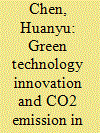

|
|
|
|
|
| Summary/Abstract |
Based on the panel data of 30 provinces in China from 2007 to 2019, this paper investigates the impact of green technology innovation on carbon intensity. Firstly, this paper studies the dynamic evolution and temporal and spatial pattern of China's provincial green technology innovation and carbon intensity. On this basis, the nonlinear spatial Durbin model (SDM) is used to explore the impact of green technology innovation on carbon intensity, and the relevant variables are controlled. The results show that there is a significant spatial agglomeration phenomenon in China's provincial green technology innovation level and carbon intensity. The direct impact of green technological innovation on carbon intensity in local region shows a significant "inverted-U" relationship, that is, when the level of green technological innovation is relatively low, green technological innovation will promote carbon emissions, while when the level of green technological innovation reaches a certain level, this promotion relationship will change into inhibition relationship. From the perspective of interregional spillover effect, green technological innovation also has an “inverted-U″ nonlinear impact on carbon emissions in adjacent regions, that is, the impact of green technological innovation on carbon emissions in adjacent regions is also promoted first and then restrained.
|
|
|
|
|
|
|
|
|
|
|
|
|
|
|
|
| 16 |
ID:
188545


|
|
|
|
|
| Summary/Abstract |
The small island economy of Papua New Guinea (PNG) is facing severe electricity shortages and is therefore turning to implementing broader power sector reforms as a vehicle to attract private capital and investments in electricity generation. This study, based on a case-study approach, revisits the reform progress and plans in the electricity sector of PNG alongside the development and integration of IPPs in its small power system. Lessons of reform experiences and IPPs integration are drawn from three other smaller systems of Nepal, Nicaragua and the Northern Territory of Australia including stakeholder consultations, which includes two IPPs of PNG. We find a widening gap between reform ‘theory’ and ‘practice’ in the PNG power sector. Cost reflective pricing is implemented while cost recovery is never achieved by the vertically integrated state-owned utility and the insolvency of this state-owned single buyer poses the greatest perceived revenue risk to the IPPs. This lack of revenue reimbursement to the IPPs by the single buyer is a barrier towards attracting private capital into electricity generation. We recommend that strong political will and strengthening of institutional arrangements are urgent reform measures to attract private capital in power generation as political instability continue.
|
|
|
|
|
|
|
|
|
|
|
|
|
|
|
|
| 17 |
ID:
188562


|
|
|
|
|
| Summary/Abstract |
The roles of multinational enterprises (MNEs) and domestically owned agents in global carbon emissions differ significantly. Industrial linkage analysis of carbon emissions can be applied to identify critical sectors and their contributions where policies need to be improved for this purpose. This study investigates the industrial linkage of domestically owned agents and MNEs in global carbon emissions during the 2005–2016 period from both the demand and supply side via a multiregional input-output method. Industrial linkages are analyzed from the perspectives of both production and spatial linkage. The results show that the forward linkages of domestic agents on the supply side mainly lead to an increase in global carbon emissions. Second, the spatial linkage is more influential than the production linkage in global carbon emissions in most cases. Global carbon emissions are spatially lock-in some specific regions, such as China and South Africa. Third, MNEs transfer energy-intensive industries to developing regions and cause carbon leakage. We highlight that spatial linkage has an important role in global carbon emissions. This study is beneficial for policy-makers in providing a reference for impartially allocating mitigation responsibility.
|
|
|
|
|
|
|
|
|
|
|
|
|
|
|
|
| 18 |
ID:
188541


|
|
|
|
|
| Summary/Abstract |
Reducing inequality in energy consumption is critical for sustainable development and the achievement of climate goals. Using an environmentally extended input-output analysis, this study measured the urban household energy consumption of different income groups in China for the years 2012, 2015, and 2017. Gini coefficients were used to measure inequality within each province, while the regional environment inequality index was used to measure inequality between provinces. The energy consumption showed a decreasing trend from the eastern coast to the western interior. In contrast, the per capita energy consumption showed an increasing trend from the southeastern coast to the northwestern interior. In 2015, the high-income groups accounted for 45% of the country's total energy consumption, while the low-income groups accounted for only 4%. Between 2012 and 2017, the level of inequality in energy consumption between provinces gradually increased, while the level of inequality within provinces gradually decreased. Among the various consumption categories, the Gini coefficients for necessities were generally smaller, whereas those for services were generally larger. However, the differences between consumption categories gradually decreased.
|
|
|
|
|
|
|
|
|
|
|
|
|
|
|
|
| 19 |
ID:
188561
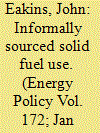

|
|
|
|
|
| Summary/Abstract |
Developing effective policy solutions to transition away from the use of solid fuels for residential heating purposes can be hindered by the lack of reliable data on its use. One such issue is the extent of informal solid fuel use, that is, consumption from sources outside of formal commercial channels. This is an area which has been largely ignored in previous empirical research. Using a survey of residential solid fuel users, the extent of solid fuel use in the residential sector in Ireland from informal sources for two fuels, sod peat and wood, is quantified. Sod peat is found to be almost exclusively sourced informally while just over half of wood use is estimated to be sourced by households in this way. Factors including location, household income, being a primary user of the fuel and having strong cost motivations all effect the probability of sourcing solid fuels informally relative to formal sources. The sizeable extent to which informal sources of solid fuels are used in Ireland arising from the analysis in this paper, highlights the potential for substitution to this unregulated alternative. This should be carefully monitored for effective implementation of new and existing solid fuel regulations.
|
|
|
|
|
|
|
|
|
|
|
|
|
|
|
|
| 20 |
ID:
188542
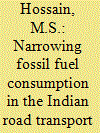

|
|
|
|
|
| Summary/Abstract |
Road transportation accounts for 56% of India's transportation sector's CO2 emissions. Reaching carbon neutrality before 2070 requires the deep decarbonization of this sector. This study assesses the potential of battery electric vehicles (BEV) and fuel-cell vehicles (FCV) as the least-cost pathway toward carbon neutrality. We estimate the future demand for passenger and freight services and evaluate the impact of EV policies using the Integrated Model of Energy, Environment, and Economy for Sustainable Development/Technology (IMED/TEC). The study covers road transport emissions, energy, and air pollution transitions under four scenarios, including reference, low, medium, and high penetration of BEV and FCV, which align with the decarbonization target agreed upon under India's national policy. Results show that the carbon neutrality target would be challenging with BEV alone in road passenger and freight transportation because it is less efficient. Combined penetration of BEV and FCV can reduce air pollutant emissions significantly. Operative implementation of FCV could diminish more than 96% of the total road transport CO2 emissions. The analytical framework also proposes local climate change policies towards a carbon neutrality strategy to escalate the share of BEV and FCV in the Indian road transport sector.
|
|
|
|
|
|
|
|
|
|
|
|
|
|
|
|
|
|
|
|
|